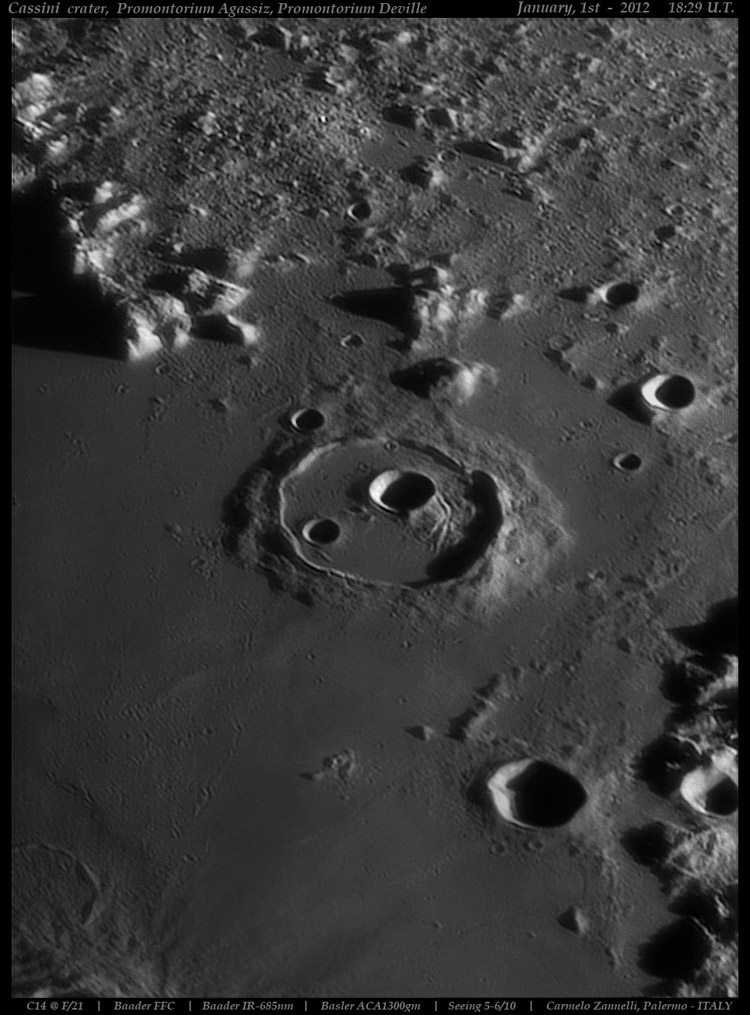Difference between revisions of "February 25, 2012"
| Line 3: | Line 3: | ||
<!-- ws:start:WikiTextHeadingRule:0:<h1> --> | <!-- ws:start:WikiTextHeadingRule:0:<h1> --> | ||
<!-- ws:start:WikiTextLocalImageRule:6:<img src="/file/view/LPOD-Feb25-12.jpg/304956804/LPOD-Feb25-12.jpg" alt="" title="" /> -->[[File:LPOD-Feb25-12.jpg|LPOD-Feb25-12.jpg]]<!-- ws:end:WikiTextLocalImageRule:6 --><br /> | <!-- ws:start:WikiTextLocalImageRule:6:<img src="/file/view/LPOD-Feb25-12.jpg/304956804/LPOD-Feb25-12.jpg" alt="" title="" /> -->[[File:LPOD-Feb25-12.jpg|LPOD-Feb25-12.jpg]]<!-- ws:end:WikiTextLocalImageRule:6 --><br /> | ||
| − | <em>image by [mailto:c.zannelli@virgilio.it | + | <em>image by [mailto:c.zannelli@virgilio.it Carmelo Zannelli], Palermo, Italy</em><br /> |
<br /> | <br /> | ||
Cassini and the possible small concentric crater behind it show up well in Mel's new image but the relatively bland area south of Cassini has become an area of interest. KC Pau's recent [http://lpod.wikispaces.com/February+22%2C+2012 LPOD] suggested to me that Aristillus - just off this image at bottom left - may have been formed by an oblique impact. KC's view showed well-developed radial ridges and gullies (R & G) to the northwest and to the southeast but not to the intermediate directions such as visible here. Mel's large scale image with a low angle of illumination clearly reveals the lack of R & G terrain, confirming the impression from KC's image. Aristillus was formed by an oblique impact, a fact that seems not to have been noticed before amateur images demonstrated it.<br /> | Cassini and the possible small concentric crater behind it show up well in Mel's new image but the relatively bland area south of Cassini has become an area of interest. KC Pau's recent [http://lpod.wikispaces.com/February+22%2C+2012 LPOD] suggested to me that Aristillus - just off this image at bottom left - may have been formed by an oblique impact. KC's view showed well-developed radial ridges and gullies (R & G) to the northwest and to the southeast but not to the intermediate directions such as visible here. Mel's large scale image with a low angle of illumination clearly reveals the lack of R & G terrain, confirming the impression from KC's image. Aristillus was formed by an oblique impact, a fact that seems not to have been noticed before amateur images demonstrated it.<br /> | ||
<br /> | <br /> | ||
| − | <em>[mailto:tychocrater@yahoo.com | + | <em>[mailto:tychocrater@yahoo.com Chuck Wood]</em><br /> |
<br /> | <br /> | ||
<strong>Technical Details</strong><br /> | <strong>Technical Details</strong><br /> | ||
Revision as of 17:45, 11 January 2015
Evidence for No Presence

image by Carmelo Zannelli, Palermo, Italy
Cassini and the possible small concentric crater behind it show up well in Mel's new image but the relatively bland area south of Cassini has become an area of interest. KC Pau's recent LPOD suggested to me that Aristillus - just off this image at bottom left - may have been formed by an oblique impact. KC's view showed well-developed radial ridges and gullies (R & G) to the northwest and to the southeast but not to the intermediate directions such as visible here. Mel's large scale image with a low angle of illumination clearly reveals the lack of R & G terrain, confirming the impression from KC's image. Aristillus was formed by an oblique impact, a fact that seems not to have been noticed before amateur images demonstrated it.
Chuck Wood
Technical Details
Celestron C14 @ F/21 – Baader FFC multiplier – Baader Ir-685nm filter – Basler ACA1300gm camera – Seeing 5-6/10.
Related Links
Rükl plate 12



